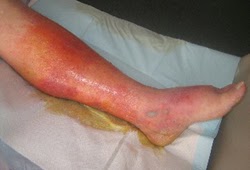Cellulitis
1. [noun] cellulitis is a common, potentially serious bacterial skin infection . The affected skin appears swollen and red and is typically painful and warm to the touch. Cellulitis usually affects the skin on the lower legs , but it can occur in the face, arms and other areas. It occurs when a crack or break in your skin allows bacteria to enter. Left untreated, the infection can spread to your lymph nodes and bloodstream and rapidly become life-threatening. It isn't usually spread from person to person. CAUSES: Cellulitis occurs when bacteria, most commonly streptococcus and staphylococcus, enter through a crack or break in your skin. The incidence of a more serious staphylococcus infection called methicillin-resistant Staphylococcus aureus (MRSA) is increasing. Although cellulitis can occur anywhere on your body, the most common location is the lower leg. Bacteria are most likely to enter disrupted areas of skin, such as where you've had recent surgery, cuts, puncture wounds, an ulcer, athlete's foot or dermatitis. Animal bites can cause cellulitis. Bacteria can also enter through areas of dry, flaky skin or swollen skin. PREVENTION: If your cellulitis recurs, your doctor may recommend preventive antibiotics. To help prevent cellulitis and other infections, take these precautions when you have a skin wound: Wash your wound daily with soap and water. Do this gently as part of your normal bathing. Apply a protective cream or ointment. For most surface wounds, an over-the-counter ointment (Vaseline, Polysporin, others) provides adequate protection. Cover your wound with a bandage. Change bandages at least daily. Watch for signs of infection. Redness, pain and drainage all signal possible infection and the need for medical evaluation. People with diabetes and those with poor circulation need to take extra precautions to prevent skin injury. Good skin care measures include the following: Inspect your feet daily. Regularly check your feet for signs of injury so you can catch infections early. Moisturize your skin regularly. Lubricating your skin helps prevent cracking and peeling. Do not apply moisturizer to open sores. Trim your fingernails and toenails carefully. Take care not to injure the surrounding skin. Protect your hands and feet. Wear appropriate footwear and gloves. Promptly treat infections on the skin's surface (superficial), such as athlete's foot. Superficial skin infections can easily spread from person to person. Don't wait to start treatment. IMPORTANT: If you identify Cellulitis it should be treated at a hospital or by doctor immediately. A doctor may prescribe antibiotics to assist in combatting the cellulitis. See: https://www.mayoclinic.org/diseases-conditions/cellulitis/symptoms-causes/syc-20370762 ; Accessed may 3 2019
Source: https://www.mayoclinic.org/diseases-conditions/cellulitis/symptoms-causes/syc-20370762

Frequently Asked Questions
How can minor skin breaks on the foot lead to an inflammatory response in nearby tissues?
Even small abrasions on the toes or ankles can allow bacteria to enter. The resulting inflammation may produce visible redness, warmth, and swelling around the affected area that can signal a developing infection.
Is cellulitis in the foot contagious if someone shares footwear or socks with another person?
Cellulitis is generally not contagious. The infection develops when bacteria enter through a break in the skin, so sharing footwear or socks is unlikely to transmit the condition from one person to another.
How does the Latin origin of the term cellulitis help us understand its impact on foot tissues?
The word originates from 'cellula', meaning small cell, highlighting how the infection produces an inflammatory reaction in the skin cells. This reaction is often observed in the foot and lower leg as swelling, redness, and warmth.